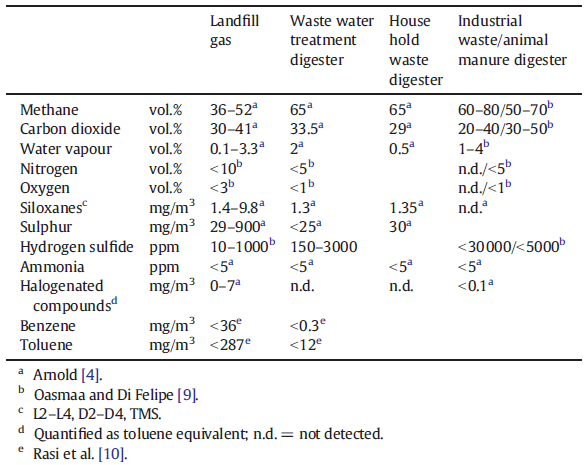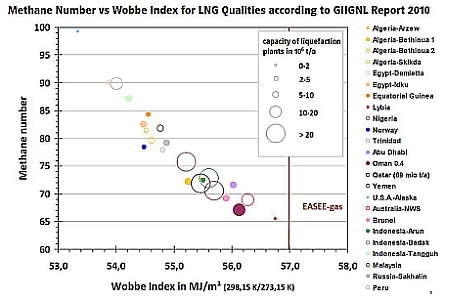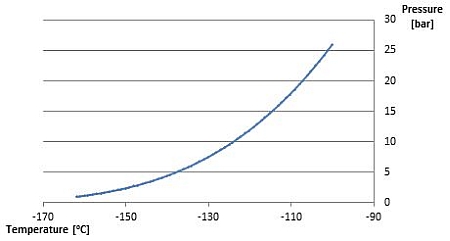Fuel properties
Natural gas (NG) is used as an energy source and as an automotive fuel to respond the need for reduction of oil dependence and thus to increase in the security of energy supply. Natural gas is a colorless, odorless, and clean-burning fuel that has been and is currently used for many different applications such as power generation, domestic use, transportation, and as a feedstock for the production of ammonia-based fertilizers.
Legislation, standards and properties
Standards for fuels are essential, as design of engines should base its work on a known fuel composition and its potential variability.
ISO 15403:2006 defines natural gas as a gas with
- more than 70% volume/mole of methane and
- a higher calorific value of 30–45 MJ/Nm3.
It also recommends limits for
- moisture and dust, 3 vol-% for both, and
- for CO2, O2, and H2S a limit of <5mg/m3.
The following European specifications for natural gas and biomethane automotive market fuels were published in 2016/2017:
- EN 16723-1 Natural gas and biomethane for use in transport and biomethane for injection in the natural gas network - Part 1: Specifications for biomethane for injection in the natural gas network (Under Approval)
- EN 16723-2 Natural gas and biomethane for use in transport and biomethane for injection in the natural gas network - Part 2: Automotive fuel specifications (Under Approval)
Requirements for natural gas and biomethane as automotive fuels as examples are presented in Table 1 together with the historical variations that were found in GASQUAL project for some relevant components between different pipeline gas specifications in Europe. Additionally, requirements presented in UNECE Regulation No. 83 (R83) for reference gas specifications (G20 and G25) in the emissions standards for light duty NGVs are presented, as well as the respective requirements in regulation R49 for heavy-duty engines (GR-G23 for H-gas range and G23-G25 for L-range).
Table 1. Example of natural gas and biomethane properties (historical) together with the requirements in the standards for automotive fuels. Complete requirements and standards are available from the respective organizations.
|
|
Historical natural gas quality in Europe (GASQUAL Project) |
G20/G25 (R83 rev. 4) |
GR/G23 (R49 rev. 7) |
Standard 2017 |
|
Methane content, mol% |
|
99-100/84-88 |
84-89/91.5-93.5 |
|
|
Ethane, mol% |
|
|
11-15/- |
|
|
Balance (Inerts) |
|
<1/<1 |
<1/<1 |
|
|
Methane number |
|
|
|
> 65
|
|
Wobbe index, MJ/Sm3 |
30.8 – 54.7 |
47.2-49.2/38.2-40.6 |
|
|
|
Total volatile silicon (as Si), mgSi/m3 |
|
|
|
≤ 0.3
|
|
Hydrogen, wt% |
|
|
|
≤ 2
|
|
Total sulfur, mg/Sm3 |
10 - 150
|
≤ 10/≤ 10
|
≤ 10/≤10 |
≤ 30
|
|
Hydrogen sulfide and carbon sulfide (as sulfur), mg/Sm3 |
2 - 20 |
|
|
≤ 5 |
|
Oxygen, mol% |
0 - 3
|
|
|
≤ 1 |
|
Amine, mg/m3 |
|
|
|
≤ 10 |
|
Dew point temperature, °C |
-15 - +2 |
|
|
≤ -2 |
|
CO2, mol% |
1 - 8
|
|
|
|
|
Nitrogen, mol% |
1.5 - 10 |
-/12-16 |
-/6.5-8.5 |
|
The methane number is an important property of natural gas. This value, which is calculated using an approach by the South West Research Institute, indicates the knocking resistance of the fuel; a methane number of 80 gives the same knocking behavior as a mixture of 20% hydrogen and 80% methane. EN 437:2003 specifies the test gases, test pressures and categories of appliances relative to the use of gaseous fuels. The Wobbe Index is an indicator of the interchangeability of fuel gases (the higher heating value divided by the square root of specific gravity). However, both standards are of limited use when looking at natural gas vehicles (NGVs) performances, fuel economy, emissions, and consumer’s price safeguard.
UNECE Regulations No. 83 and 49 (see Table above) define the reference the reference gas specifications, which are supposed to be representative of the different existing market qualities. An essential problem is the extent to which the reference fuels used in emission tests have properties similar to the properties of the fuel in the real-world situation. The following summary and Table 1 summarize some critical information and provides relevant correlations:
- Biomethane, particularly in its liquid form (LBM) is the nearest to the G20 reference test-gas (pure methane). Liquefaction eliminates CO2, sulfur, and metals that are present in raw biogas.
- Over 95% of LNG typically has higher grades than G23 test-gas and high grade pipeline gas. LNG contains very little nitrogen, while G23 is generated by diluting methane with ~ 7.5% nitrogen.
- Low grade pipeline gas is simulated by G25 test-gas, which is generated by adding ~ 14% of nitrogen to methane. However, L-gas has higher contents of C2, giving higher Wobbe Index and lower methane number than G25.
- The high C2-contents of the Rich-LNG is simulated by GR test-gas by adding 13% of ethane to methane. However Rich-LNG has higher contents of C3+, giving higher Wobbe Index and lower methane number than GR
A broad conclusion is that G23, G25, and GR reference test-gas formulations are not really representative of the actual composition available in the gas-pipeline and LNG markets. In the test-gases methane is diluted with either nitrogen or ethane, while methane in actual gas is “diluted” by both ethane (and C3+) and/or inerts (N2 and CO2), depending on source.
Table 1. Typical NG/biomethane compositions in the NGVA Europe’s LNG Position Paper (A. Nicotra - 2012).
|
|
LBM |
High-Gas/LNG-std |
Low-Gas/Rich-LNG |
|
Methane, mol% |
98 |
93/93 |
82/83 |
|
Ethane, mol% |
- |
5/5.5 |
5/13 |
|
C3+, mol% |
- |
-/2 |
-/3 |
|
Nitrogen, mol% |
2 |
2/0.5 |
13/0.5 |
|
Sulfur, mg/kg |
3 |
10/3 |
10/3 |
|
Wobbe index |
46 |
46.2/47.5 |
43.3/49.5 |
|
Methane number |
90-95 |
75-90/75-90 |
60-70/63-70 |
|
MON |
135-137 |
124-134/124/134 |
113-120/115-120 |
Natural gas is a mixture of different hydrocarbons, methane being the main constituent (usually 87–97%). It can also contain some impurities such as nitrogen or CO2. For natural gas, main variations include:
- calorific value
- methane number
- sulfur content
- content on inerts (nitrogen and carbon dioxide)
- content of higher hydrocarbons
Biomethane is upgraded from biogas, which mainly consists of methane and CO2 plus some minor/trace components which greatly depend on the feedstock (Table 3).
Table 3. Examples of biogas compositions from different sources (Kajolinna et al. 2015).

Final quality and composition of biomethane depends on the operational parameters of the final use and on the upgrading technology used (Table 4). Depending on the source, several trace components have to be closely controlled when using biomethane as a vehicle fuel, including:
- Siloxanes (risk of abrasion and increased probability for knocking)
- Hydrogen (risk of embrittlement for the metallic materials)
- Water (risk of corrosion and driveability problems)
- Hydrogen sulfide, H2S (corrosive in the presence of water could affect after-treatment devices, and combustion products could create problems by sticking the engine valves)
Table 4. Comparison of selected parameters for common upgrading processes (Urban et al. 2008).
|
|
PSA |
Water scrubbing |
Organic physical scrubbing |
Chemical scrubbing |
|
Pre-cleaning needed a |
Yes |
No |
No |
Yes |
|
Working pressure (bar) |
4–7 |
4–7 |
4–7 |
No pressure |
|
Methane loss b |
<3%/6–10% f |
<1% / <2% g |
2–4% |
<0.1% |
|
Methane content in upgraded gas c |
>96% |
>97% |
>96% |
>99% |
|
Electricity consumption (kWh/Nm3) |
0.25 |
<0.25 |
0.24–0.33 |
<0.15 |
|
Heat requirement (°C) |
No |
No |
55–80% |
50–100% |
|
Controllability compared to nominal load |
± 10–15% |
10–100% |
10–100% |
50–100% |
a Refers to raw biogas with less than 500 mg/m3 of H2S. b The methane loss depends on operating conditions. These figures are given by manufacturers or operators. c The quality of biomethane is a function of operational parameters. d Raw gas compressed to 7 bar. f CarboTech./Quest Air. g Malmberg / Flotech.
LNG suffers from the great variety of import sources and final uses. Figure 1 shows how methane number and Wobbe index vary for imported LNG in Europe:

Figure 1. Methane number vs. Wobbe index for imported LNG in Europe. (GIIGNL 2010 / E. ON Ruhrgas).
The relation between temperature and pressure for saturated LNG is seen in the Figure 2.

Figure 2. LNG (as pure CH4) saturated pressure/temperature relation (NGVA Europe. Data from NIST).
All in all, as a consequence of the multi-use nature of NG as an energy carrier together with the different import sources, the natural gas market is characterized by a substantial variation in the gas composition. This is an important factor when using methane as automotive fuel.


